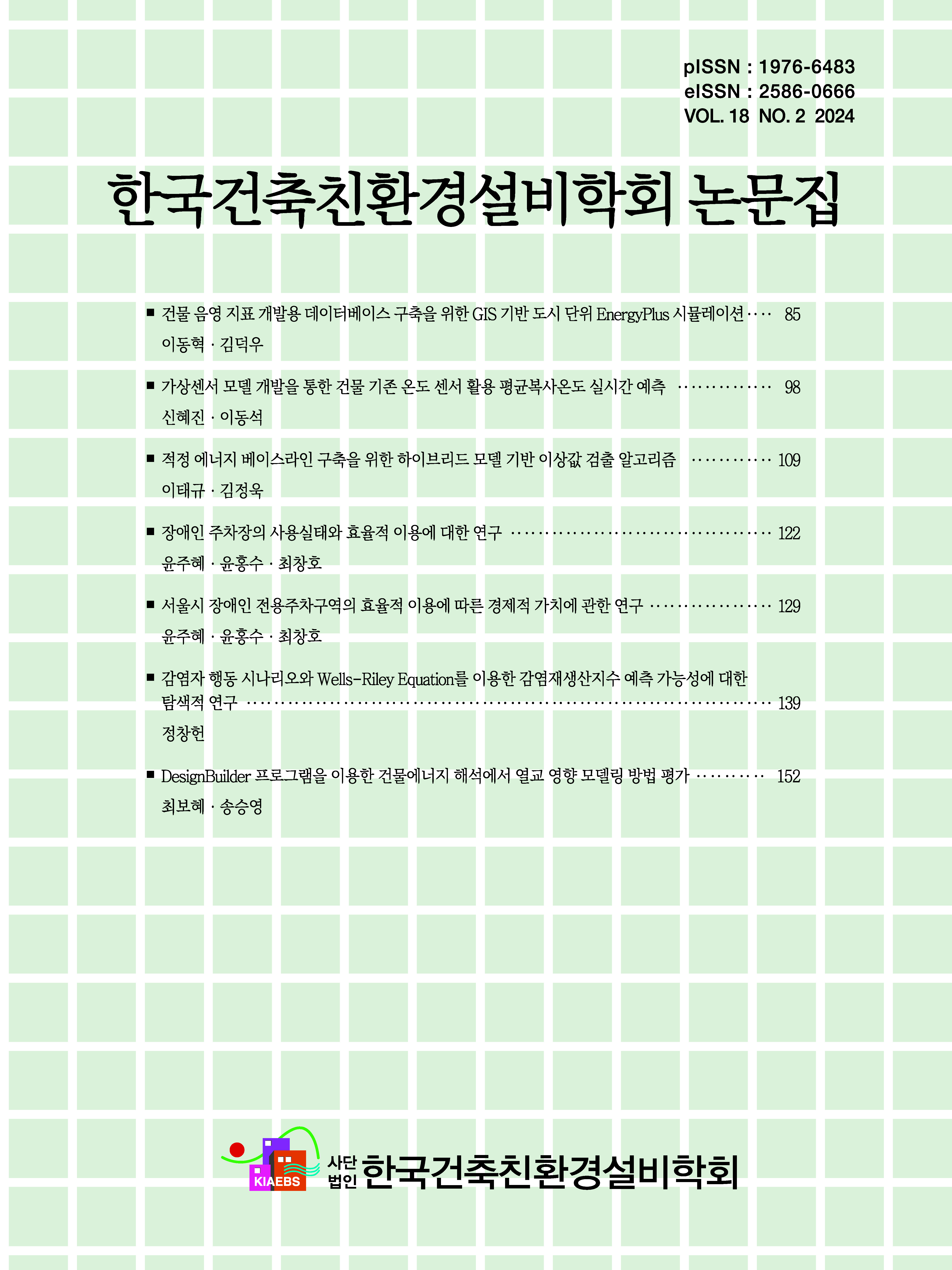Research Article
Ahn, K.U., Kim, Y.M., Kim, Y.S., Yoon, S.H., Shin, H.S., Park, C.S. (2016). Development of a Profiling System for Energy Performance Assessment of Existing Buildings. Journal of the Architectural Institute of Korea Structure & Construction, 32(12), 77-87.
10.5659/JAIK_SC.2016.32.12.77Chan, A.L.S. (2012). Effect of adjacent shading on the thermal performance of residential buildings in a subtropical region. Applied Energy, 92, 516-522.
10.1016/j.apenergy.2011.11.063Chow, T.T., Chan, A.L., Song, C.L. (2004). Building-mix optimization in district cooling system implementation. Applied Energy, 77(1), 1-13.
10.1016/S0306-2619(03)00102-8Crawley, D.B., Lawrie, L.K., Winkelmann, F.C., Buhl, W.F., Huang, Y.J., Pedersen, C.O., Strand, R.K., Liesen, R.J., Fisher, D.E., Witter, M.J., Glazer, J. (2001). EnergyPlus: creating a new-generation building energy simulation program. Energy and buildings, 33(4), 319-331.
10.1016/S0378-7788(00)00114-6Hong, T., Chang, W.K., Lin, H.W. (2013). A fresh look at weather impact on peak electricity demand and energy use of buildings using 30-year actual weather data. Applied Energy, 111, 333-350.
10.1016/j.apenergy.2013.05.019Hong, T., Chen, Y., Lee, S.H., Piette, M.A. (2016). CityBES: A web-based platform to support city-scale building energy efficiency. Urban Computing, 14.
Hsieh, C.M., Li, J.J., Zhang, L., Schwegler, B. (2018). Effects of tree shading and transpiration on building cooling energy use. Energy and Buildings, 159, 382-397.
10.1016/j.enbuild.2017.10.045Ichinose, T., Lei, L., Lin, Y. (2017). Impacts of shading effect from nearby buildings on heating and cooling energy consumption in hot summer and cold winter zone of China. Energy and Buildings, 136, 199-210.
10.1016/j.enbuild.2016.11.064Javanroodi, K., Mahdavinejad, M., Nik, V.M. (2018). Impacts of urban morphology on reducing cooling load and increasing ventilation potential in hot-arid climate. Applied Energy, 231, 714-746.
10.1016/j.apenergy.2018.09.116Jung, M.S., Moon, C.J., Chang, Y.H., Kim, Y.G., Lee, S.H. (2018). A Study on Design of Optimal Location for Renewable Energy Facility Using GIS. The Journal of the Korea Institute of Electronic Communication Sciences, 13(2), 357-368.
Katal, A., Mortezazadeh, M., Wang, L.L. (2019). Modeling building resilience against extreme weather by integrated CityFFD and CityBEM simulations. Applied Energy, 250, 1402-1417.
10.1016/j.apenergy.2019.04.192Kim, E.J. (2014). Development of a solar insolation calculation module in urban context using the sunlit fraction and sky-view factor. Journal of the Architectural Institute of Korea Planning & Design, 30(7), 229-236.
10.5659/JAIK_PD.2014.30.7.229Kim, K., Yi, C., Lee, S. (2019). Impact of urban characteristics on cooling energy consumption before and after construction of an urban park: The case of Gyeongui line forest in Seoul. Energy and Buildings, 191, 42-51.
10.1016/j.enbuild.2019.03.011Ko, J.H., Huh, J.H. (2015). Analysis of Cooling and Heating Loads considering the Impact of Solar Shading by Adjacent Buildings in Density Cities. Journal of the Architectural Institute of Korea Planning & Design, 31(7), 57-64.
10.5659/JAIK_PD.2015.31.7.57Lam, J.C. (2000). Shading effects due to nearby buildings and energy implications. Energy Conversion and Management, 41(7), 647-659.
10.1016/S0196-8904(99)00138-7Lindberg, F., Grimmond, C.S.B., Gabey, A., Huang, B., Kent, C.W., Sun, T., Theeuwes, N.E., Järvi, L., Ward, H.C., Capel-Timms, I., Chang, Y., Jonsson, P., Krave, N., Liu, D., Meyer, D., Olofson, K.F.G., Tan, J., Wästberg, D., Xue, L., Zhang, Z. (2018). Urban Multi-scale Environmental Predictor (UMEP): An integrated tool for city-based climate services. Environmental Modelling & Software, 99, 70-87.
10.1016/j.envsoft.2017.09.020Lu, X., Hinkelman, K., Fu, Y., Wang, J., Zuo, W., Zhang, Q., Saad, W. (2019). An open source modeling framework for interdependent energy-transportation-communication infrastructure in smart and connected communities. IEEE Access, 7, 55458-55476.
10.1109/ACCESS.2019.2913630Oregi, X., Hermoso, N., Prieto, I., Izkara, J.L., Mabe, L., Sismanidis, P. (2018). Automatised and georeferenced energy assessment of an Antwerp district based on cadastral data. Energy and Buildings, 173, 176-194.
10.1016/j.enbuild.2018.05.018Pisello, A.L., Pignatta, G., Castaldo, V.L., Cotana, F. (2015). The impact of local microclimate boundary conditions on building energy performance. Sustainability, 7(7), 9207-9230.
10.3390/su7079207Qomi, M.J., Noshadravan, A., Sobstyl, J.M., Toole, J., Ferreira, J., Pellenq, R.J.M., Ulm, F., Gonzalez, M.C. (2016). Data analytics for simplifying thermal efficiency planning in cities. Journal of the Royal Society Interface, 13(117), 20150971.
10.1098/rsif.2015.097127097652PMC4874424Simá, E., Chagolla-Aranda, M.A., Huelsz, G., Tovar, R., Alvarez, G. (2015, 12). Tree and neighboring buildings shading effects on the thermal performance of a house in a warm sub-humid climate. Building Simulation, 8(6), 711-723.
10.1007/s12273-015-0247-2Sutherland, I.E., Hodgman, G.W. (1974). Reentrant polygon clipping. Communications of the ACM, 17(1), 32-42.
10.1145/360767.360802Weiler, K., Atherton, P. (1977). Hidden surface removal using polygon area sorting. ACM SIGGRAPH Computer Graphics, 11(2), 214-222.
10.1145/965141.563896Li, N., Yi, D.H,, Bansal, P. Quan, S.J. (2021). Urban Form Typology and Building Energy Use: Empirical Investigation in Seoul. Proceedings of the CUE 2021-Applied Energy Symposium 2021: Low carbon cities and urban energy systems, Matsue, Japan/Virtual, Sept. 4-8, 2021.
Yu, C., Pan, W. (2018). Effects of shading on the energy consumption of high-rise office buildings in Hong Kong. In 2018 Building Performance Analysis Conference and SimBuild. ASHRAE.
Ministry of Land, Infrastructure and Transport (MOLIT). (2021). 2050 Carbon Neutrality Roadmaps, Ministry of Land, Infrastructure and Transport.
Augenbroe, G. (2012). The role of simulation in performance based building. In Building Performance Simulation for Design and Operation. London: Routledge, 39-60.
Moon, S.J. (2013). The Study on Supervised Classification about Satellite Imagery for the Mapping of Wind Resource, Master's Thesis, Jeju National University.
Oh, M.C. (2020). Development of GIS based PV Power Calculation Algorithm Considering Building Roofs and Facades using High-resolution Urban Spatial Data, Doctoral Thesis, Seoul National University.
Ministry of the Interior and Safety (MOIS). (2023). Address-Based Industry Support Service. Avaiable at: https://business.juso.go.kr [Accessed on December 26, 2023].
National Renewable Energy Laboratory (NREL). (2023). NSRDB: National Solar Radiation Database. Avaiable at: https://nsrdb.nrel.gov [Accessed on December 26, 2023].
- Publisher :Korean Institute of Architectural Sustainable Environment and Building Systems
- Publisher(Ko) :한국건축친환경설비학회
- Journal Title :Journal of Korean Institute of Architectural Sustainable Environment and Building Systems
- Journal Title(Ko) :한국건축친환경설비학회논문집
- Volume : 18
- No :2
- Pages :85-97
- Received Date : 2023-12-27
- Revised Date : 2024-03-02
- Accepted Date : 2024-03-20
- DOI :https://doi.org/10.22696/jkiaebs.20240008




 Journal of Korean Institute of Architectural Sustainable Environment and Building Systems
Journal of Korean Institute of Architectural Sustainable Environment and Building Systems








